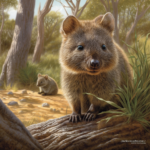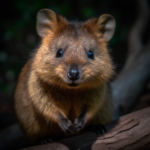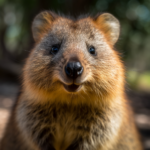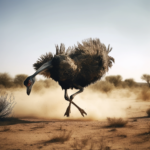The Quokka is a small marsupial native to Western Australia. Known for its friendly and curious nature, the Quokka has gained popularity as one of the world’s happiest animals. With its adorable appearance and photogenic smile, it has become a social media sensation, attracting tourists and wildlife enthusiasts from around the globe. Despite its cute and cuddly appearance, the Quokka is a wild animal and should be treated with respect and caution. In this article, we will explore the fascinating world of the Quokka, including its habitat, behavior, diet, and conservation status. So, let’s dive in and discover more about this delightful creature!
Key Takeaways
- Quokkas are small marsupials found in Western Australia.
- They are known for their friendly and curious nature, often approaching humans.
- Quokkas have become popular due to their photogenic smiles and selfies with them have become a trend.
- Conservation efforts are important to protect the quokka population and their habitat.
Understanding the Quokka
A. What is a Quokka?
The quokka, scientifically known as Setonix brachyurus, is a small marsupial native to Western Australia. Often referred to as the “happiest animal on Earth,” the quokka has gained significant attention in recent years due to its friendly and photogenic nature. These herbivorous mammals are part of the kangaroo family and share similarities with their larger relatives.
Quokkas are primarily found on Rottnest Island, a small island off the coast of Western Australia. This island serves as a sanctuary for these unique creatures, allowing them to thrive in their natural habitat. The quokka population on Rottnest Island is estimated to be around 10,000, making it the largest concentration of quokkas in the world.
B. Quokka: The Marsupial from Australia
The quokka is a marsupial, which means it carries its young in a pouch. Female quokkas have a gestation period of just over a month, after which they give birth to a tiny joey. The joey then crawls into its mother‘s pouch, where it continues to develop and grow for several months. This pouch provides a safe and nurturing environment for the baby quokka until it is ready to venture out on its own.
One of the most distinctive features of the quokka is its unique appearance. These small wallabies have a stocky build with a rounded face and short, rounded ears. They have a dense, coarse fur that ranges in color from brown to gray. Quokkas also have a short tail and strong hind legs, which enable them to hop and move quickly.
C. The Unique Appearance of Quokka
Quokkas have become famous for their adorable and photogenic appearance. Their friendly facial expressions, often described as a perpetual smile, have earned them the title of the “happiest animal on Earth.” This unique feature has made them incredibly popular among tourists, who flock to Rottnest Island to capture quokka selfies.
Apart from their endearing smile, quokkas have other physical characteristics that make them stand out. Their small size, measuring around 16 to 21 inches in length, and their round, compact bodies give them a charming and cuddly appearance. Their fur is thick and coarse, providing protection from the harsh Australian climate.
D. The Quokka Diet: What do Quokkas Eat?
As herbivores, quokkas primarily feed on a diet consisting of leaves, grasses, and other plant material. They have adapted to survive in their island habitat by consuming a variety of vegetation. Quokkas are known to eat the leaves and bark of shrubs, as well as grasses and fruits. They have specialized teeth that allow them to efficiently chew and digest their food.
Due to the limited resources on Rottnest Island, quokkas have also developed the ability to extract moisture from their food. This adaptation enables them to survive in the arid conditions of their habitat, where water sources may be scarce. However, despite their ability to extract moisture, quokkas still require access to fresh water to maintain their overall health.
E. How Quokkas Move: A Look at their Locomotion
Quokkas are skilled hoppers, using their powerful hind legs to move swiftly across their island home. Their hopping style is similar to that of kangaroos, with their strong legs propelling them forward in a series of bounds. This mode of locomotion allows them to cover large distances quickly and efficiently.
In addition to hopping, quokkas are also capable climbers and swimmers. Their agile nature enables them to navigate through various terrains, including rocky areas and dense vegetation. Quokkas are known to take refuge in trees or bushes when threatened by predators, using their climbing abilities to escape danger.
Overall, the quokka is a fascinating marsupial with a unique appearance and charming personality. Its presence on Rottnest Island and its interaction with humans have made it an iconic symbol of Australian wildlife. As efforts continue to protect and conserve this endangered species, the quokka remains a beloved ambassador for animal conservation and a delight for wildlife enthusiasts and photographers alike.
The Quokka Habitat

The habitat of the quokka, a small marsupial native to Western Australia, is as unique as the animal itself. Let’s explore where these adorable creatures live, their primary habitat on Quokka Island, and how they have adapted to their environment.
A. Where Do Quokkas Live?
Quokkas are primarily found on Rottnest Island, located off the coast of Western Australia. This small island, also known as “Quokka Island,” is home to a significant population of these herbivorous mammals. The isolation of Rottnest Island has played a crucial role in preserving the quokka population and their natural habitat.
B. Quokka Island: The Primary Habitat
Rottnest Island provides an ideal environment for quokkas to thrive. The island is free from natural predators, allowing these small wallabies to roam freely without the constant threat of predation. This lack of predators has contributed to the quokka’s reputation as one of the happiest animals on Earth.
The vegetation on Quokka Island is diverse and abundant, providing a plentiful food source for these herbivores. Quokkas primarily feed on grasses, leaves, and other plant material found on the island. The island‘s climate, characterized by mild winters and warm summers, further supports the growth of vegetation, ensuring a steady food supply for the quokkas throughout the year.
C. The Quokka’s Adaptation to its Environment
Quokkas have developed several adaptations that enable them to thrive in their island habitat. One of the most notable adaptations is their ability to reproduce. Female quokkas have a unique reproductive system where they can delay the development of a fertilized egg until environmental conditions are favorable. This adaptation allows them to ensure the survival of their young, known as joeys, during times of scarcity.
Another remarkable adaptation of quokkas is the presence of a pouch on the females. Similar to other marsupials, female quokkas have a pouch where they carry and nurse their joeys. The pouch provides a safe and protected environment for the young quokkas to develop and grow. This adaptation is crucial for the survival of the species, as it allows the mother to carry her offspring while foraging for food.
Additionally, quokkas have evolved to be primarily nocturnal animals. They are most active during the night when the temperature is cooler, reducing the risk of dehydration. This adaptation also helps them avoid potential predators that are more active during the day.
In conclusion, the quokka’s habitat on Quokka Island provides a safe haven for these unique creatures. The absence of natural predators, coupled with a diverse food supply, has allowed the quokka population to flourish. Their adaptations, such as delayed reproduction and the presence of a pouch, further contribute to their survival in this environment. Quokkas are a testament to the resilience and adaptability of Australian fauna, and their presence on Quokka Island is a testament to the importance of wildlife conservation efforts.
The Quokka Lifestyle
A. The Quokka Baby: A Peek into their Early Life
Quokkas, also known as Setonix brachyurus, are small marsupials native to Western Australia. These herbivorous mammals are often referred to as the “happiest animal on earth” due to their friendly and curious nature. Quokkas are primarily found on Rottnest Island, where they have become an iconic symbol of Australian wildlife.
One of the most fascinating aspects of the quokka’s life is their unique reproductive process. Female quokkas have a pouch, similar to other marsupials, where they carry their young. After a gestation period of just over a month, the mother gives birth to a tiny quokka joey, which is about the size of a grape.
The joey immediately crawls into its mother‘s pouch, where it will spend the next six to seven months developing and growing. During this time, the joey relies on its mother for nourishment and protection. It is truly a remarkable sight to witness a mother quokka with a joey peeking out of her pouch.
B. The Quokka’s Social Behavior: Why are Quokkas so Friendly?
One of the reasons why quokkas have gained such popularity is their incredibly friendly and sociable nature. These nocturnal animals are known for their willingness to approach humans and interact with them. This behavior has led to the rise of “quokka selfies,” where tourists capture photos with these adorable creatures.
The quokka’s friendliness can be attributed to the lack of natural predators on Rottnest Island. With limited threats, quokkas have evolved to be more trusting and curious. They have not developed a fear response towards humans, making them more open to interactions.
Additionally, quokkas are highly social animals and live in small family groups. They engage in grooming behaviors, which helps to strengthen social bonds within the group. This social behavior extends to their interactions with humans, as they perceive them as part of their social environment.
C. The Quokka Smile: Why Do Quokkas Smile?
One of the most endearing features of quokkas is their seemingly constant smile. Their upturned mouth gives the impression of a cheerful expression, earning them the title of the “world’s happiest animal.” But why do quokkas smile?
Contrary to popular belief, the quokka smile is not a reflection of their emotional state. It is a natural facial feature that is a result of their unique jaw structure. The positioning of their lips and teeth creates the appearance of a smile, even when they are not necessarily happy or content.
While the quokka smile may not indicate their emotional state, it certainly adds to their charm and appeal. It is one of the reasons why people are drawn to these adorable creatures and why they have become a popular subject for wildlife photography.
D. The Quokka Sounds: Communicating in the Wild
While quokkas are known for their friendly behavior, they also have a range of vocalizations that they use to communicate with each other. These sounds play a crucial role in their social interactions and survival in the wild.
Quokkas produce a variety of vocalizations, including clicks, grunts, and hisses. These sounds are used for different purposes, such as attracting mates, warning others of potential threats, and maintaining social cohesion within their groups.
By listening to the sounds of quokkas, researchers have been able to gain insights into their behavior and social dynamics. These vocalizations help quokkas establish territories, communicate dominance, and coordinate group activities.
In conclusion, the quokka lifestyle is a fascinating subject to explore. From their early life as tiny joeys in their mother’s pouch to their friendly and sociable behavior, quokkas continue to captivate the hearts of people around the world. Their constant smile and unique vocalizations only add to their charm, making them a true treasure of Australian fauna.
The Quokka’s Survival Tactics

A. How Do Quokkas Escape Predators?
Quokkas, also known as the “happiest animal on Earth,” have developed several survival tactics to escape from predators. These small wallabies, scientifically known as Setonix brachyurus, are native to Western Australia and are primarily found on Rottnest Island. Being herbivorous mammals, their main concern is avoiding becoming prey for larger carnivores.
-
Camouflage: Quokkas have a natural advantage when it comes to blending into their environment. Their fur is a mix of brown and gray tones, which helps them blend in with the vegetation on the island. This camouflage makes it difficult for predators to spot them, especially during the night when they are most active.
-
Alertness: Quokkas have excellent senses, including sharp eyesight and hearing. They are always on high alert, constantly scanning their surroundings for any signs of danger. This heightened awareness allows them to detect predators early and take evasive action.
-
Agility: Despite their small size, quokkas are surprisingly agile. They can quickly maneuver through dense vegetation, making it challenging for predators to catch them. Their strong hind legs enable them to hop and leap with ease, allowing them to escape into the safety of the underbrush.
-
Group behavior: Quokkas are social animals and often live in small groups. This group behavior provides them with added protection against predators. When a predator approaches, quokkas will emit warning calls to alert others in the group. This collective response can confuse and deter predators, making it harder for them to single out an individual quokka.
B. The Quokka’s Unusual Defense Mechanism: Throwing Babies
One of the most unique defense mechanisms of quokkas is their ability to throw their babies, known as joeys, out of their pouches. While this may sound shocking, it is actually a survival strategy employed by the mother quokka to protect her offspring from predators.
When a quokka senses danger, such as the approach of a predator, she will forcefully eject her joey from her pouch. This action startles the predator and gives the mother quokka a chance to escape. The joey, being small and agile, can quickly find cover in the vegetation, while the mother leads the predator away.
This behavior may seem extreme, but it demonstrates the quokka’s strong maternal instinct and willingness to sacrifice for the survival of her young. Once the threat has passed, the mother quokka will retrieve her joey and continue to care for it.
C. Are Quokkas Fast? A Look at their Speed
Quokkas may not be the fastest animals in the animal kingdom, but they possess remarkable speed for their size. Their small stature allows them to move swiftly through their habitat, evading predators and covering considerable distances in search of food.
While there is no precise data on the top speed of quokkas, they are estimated to reach speeds of up to 12 miles per hour (19 kilometers per hour). This speed, combined with their agility, makes it challenging for predators to catch them.
Quokkas are primarily nocturnal animals, which means they are most active during the night. This nocturnal behavior further enhances their chances of survival, as they can take advantage of the cover of darkness to move around undetected.
In conclusion, quokkas have developed a range of survival tactics to escape predators. Their ability to camouflage, stay alert, exhibit agility, and employ group behavior all contribute to their survival. Additionally, the unique defense mechanism of throwing their babies allows quokkas to protect their young while ensuring their own safety. Despite not being the fastest animals, quokkas’ speed and nocturnal behavior further enhance their chances of survival in their natural habitat.
The Quokka’s Conservation Status
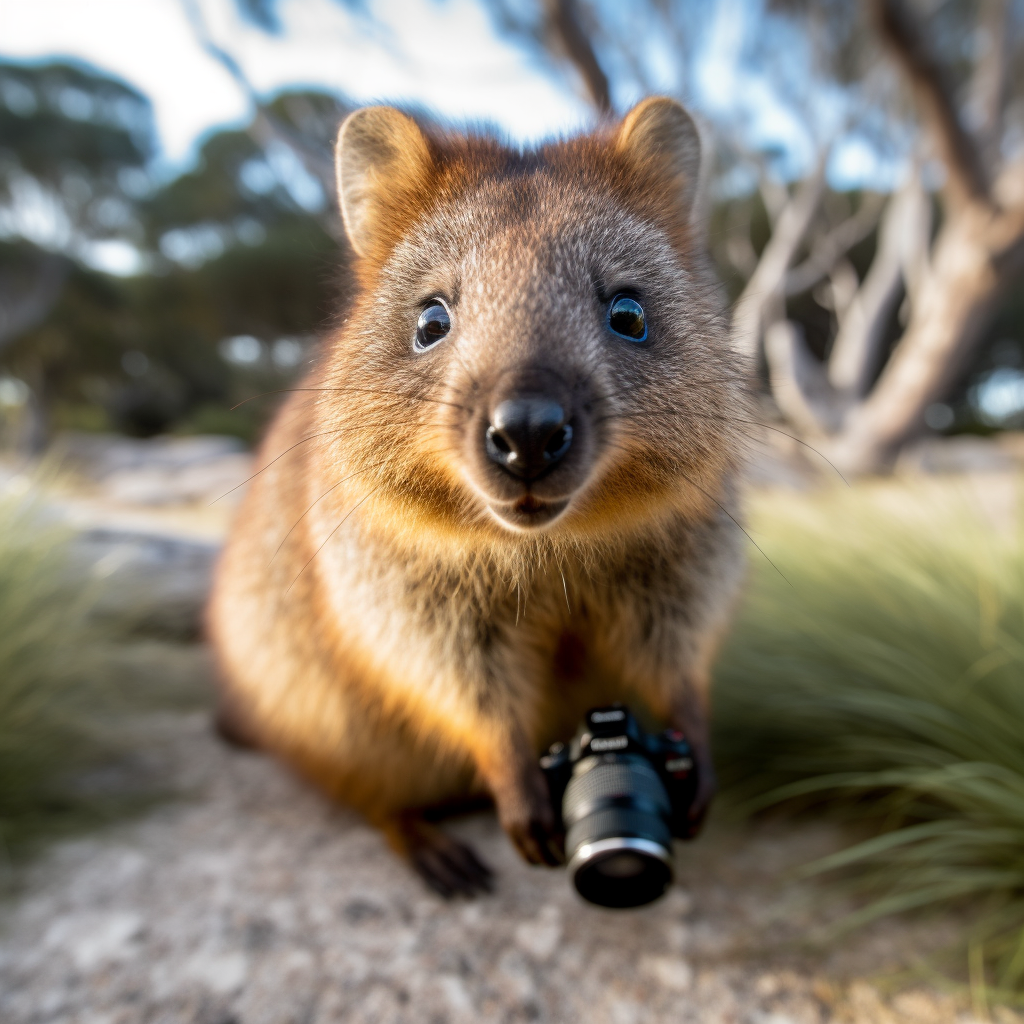
The Quokka, scientifically known as Setonix brachyurus, is a small marsupial native to Western Australia. Often referred to as the “happiest animal on Earth,” the Quokka has gained significant attention in recent years due to its friendly and photogenic nature. However, behind their adorable smiles lies a concerning conservation status that demands attention.
A. Why are Quokkas Endangered?
The Quokka’s endangered status can be attributed to several factors. One of the primary reasons is the decreasing population of these herbivorous mammals. Quokkas are endemic to a few small islands off the coast of Western Australia, with Rottnest Island being their most well-known habitat. The limited distribution of Quokkas makes them vulnerable to various threats.
B. The Decreasing Quokka Population: Causes and Concerns
Several factors contribute to the declining Quokka population. One of the major concerns is habitat loss. As human activities continue to encroach upon their natural habitat, Quokkas face the loss of their homes and food sources. Additionally, the introduction of non-native predators, such as foxes and cats, has further threatened the Quokka population.
Another significant concern is the impact of climate change. Rising temperatures and altered rainfall patterns can disrupt the delicate balance of the Quokka’s ecosystem. Changes in vegetation and availability of food can have severe consequences for these marsupials, leading to a decline in their numbers.
C. How Many Quokkas are Left? A Look at Current Numbers
Estimating the exact number of Quokkas in the wild is challenging due to their limited distribution and elusive nature. However, conservation efforts have been made to monitor and protect their population. According to recent surveys, it is estimated that there are around 8,000 to 12,000 Quokkas remaining in the wild.
To ensure the survival of this endangered species, various initiatives have been implemented. These include the establishment of protected areas, predator control programs, and public awareness campaigns. Efforts are also being made to restore and expand the Quokka’s habitat, allowing them to thrive in a more secure environment.
In conclusion, the Quokka’s conservation status is a matter of concern. With their limited distribution, habitat loss, and the impact of climate change, the Quokka population is under threat. However, ongoing conservation efforts aim to protect and preserve these adorable marsupials for future generations to enjoy. It is crucial that we continue to support these initiatives and raise awareness about the importance of preserving our unique and diverse wildlife.
The Cultural Significance of Quokkas
A. What Does Quokka Mean in Aboriginal Culture?
In Aboriginal culture, the quokka holds a special place. The word “quokka” itself is derived from the Nyungar language, spoken by the indigenous people of Western Australia. While the exact meaning of the word is not known, it is believed to refer to the quokka’s unique appearance and behavior.
The quokka is considered a sacred animal by the Aboriginal people, and it features prominently in their stories and artwork. It is often depicted as a symbol of resilience, adaptability, and survival. The quokka’s ability to thrive in harsh environments and its gentle nature make it a powerful symbol of strength and perseverance.
B. The Quokka Selfie: A Trend with Impact
In recent years, the quokka has gained international fame thanks to the rise of the “quokka selfie” trend. These adorable marsupials have become social media sensations, with people flocking to Rottnest Island in Western Australia to capture the perfect selfie with a quokka.
The quokka selfie trend has had a significant impact on tourism in the region. Visitors from around the world are drawn to Rottnest Island to experience the joy of interacting with these friendly creatures. The quokka’s photogenic nature and seemingly permanent smile make it the perfect subject for a memorable selfie.
Beyond the tourism industry, the quokka selfie trend has also helped raise awareness about animal conservation. By showcasing the quokka’s natural habitat and promoting responsible interaction with wildlife, the trend has sparked conversations about the importance of preserving the environment and protecting endangered species.
C. Why Quokkas are Important to Australia
Quokkas play a vital role in the Australian ecosystem. As herbivorous mammals, they help maintain the balance of plant life by grazing on vegetation. Their diet consists mainly of grasses, leaves, and bark, making them important contributors to the dispersal of seeds and the growth of new plants.
In addition to their ecological significance, quokkas are also an important part of Australia’s cultural heritage. They are native to Western Australia and are considered an iconic species of Australian fauna. Their presence in the region is a testament to the unique biodiversity found in Australia.
Unfortunately, the quokka population is facing challenges. Habitat loss, predation, and climate change pose threats to their survival. Efforts are being made to protect their natural habitat and ensure their long-term survival. Conservation initiatives and research projects are underway to better understand their behavior, reproduction, and population dynamics.
In conclusion, the quokka holds immense cultural significance in Aboriginal culture, has gained global attention through the quokka selfie trend, and plays a crucial role in the Australian ecosystem. By appreciating and protecting these adorable creatures, we can contribute to the preservation of Australia’s natural heritage and promote a sustainable future for all species.
The Quokka’s Interaction with Humans
A. The Quokka Pet: A Topic Of Discussion
The Quokka, also known as Setonix brachyurus, is a small wallaby species native to Western Australia. With their adorable appearance and seemingly friendly nature, many people are drawn to the idea of keeping a Quokka as a pet. However, it is important to note that the idea of owning a Quokka as a pet is highly controversial and generally discouraged.
Quokkas are wild animals and have specific needs that are difficult to meet in a domestic setting. They require a specific diet, habitat, and social structure that cannot be easily replicated in a home environment. Additionally, Quokkas are nocturnal animals, meaning they are most active during the night. This can be disruptive to a household’s daily routine.
Furthermore, the Quokka population is already considered endangered, and keeping them as pets can contribute to their decline in the wild. It is crucial to prioritize animal conservation and ensure the survival of this unique species in its natural habitat.
B. What Happens if You Touch a Quokka?
While Quokkas may appear friendly and approachable, it is important to remember that they are still wild animals. Interacting with them should be done with caution and respect for their natural behavior. If you come across a Quokka in the wild, it is generally best to observe them from a distance and avoid touching them.
Quokkas have a natural fear of predators, and if they feel threatened or cornered, they may become defensive. This can result in them scratching or biting in self-defense. Additionally, touching a Quokka can disrupt their natural behavior and cause stress, which is detrimental to their well-being.
It is also worth noting that in some areas, such as Rottnest Island, where Quokkas are commonly found, it is illegal to touch or handle them. This is to protect the Quokkas and ensure their safety and conservation.
C. Why is the Quokka Known as the Happiest Animal in the World?
The Quokka has gained worldwide fame for its reputation as the “happiest animal in the world.” This title is attributed to their cheerful and friendly facial expressions, which often resemble a smile. But what makes the Quokka so seemingly happy?
One reason for their joyful appearance is their natural behavior. Quokkas are herbivorous mammals that primarily feed on grasses, leaves, and other vegetation. Their diet provides them with the necessary nutrients to thrive, which contributes to their overall well-being.
Another factor that contributes to their happiness is their unique reproductive behavior. Female Quokkas have a specialized pouch where they carry their young, called joeys. These joeys spend several months developing and growing inside their mother’s pouch, creating a strong bond between mother and baby.
The Quokka’s habitat also plays a role in their happiness. They are found in the southwestern part of Western Australia, particularly on islands like Rottnest Island. These islands provide a safe haven for Quokkas, free from natural predators. The abundance of food and the absence of threats contribute to their contentment.
Lastly, the Quokka’s interaction with humans has also played a part in their reputation as the happiest animal. Their friendly and curious nature has made them popular subjects for wildlife photography, and the trend of taking “Quokka selfies” has gained significant attention on social media. This positive interaction with humans has further enhanced their image as a happy and approachable species.
In conclusion, while the Quokka’s happiness may be subjective, their unique behavior, habitat, and interaction with humans have contributed to their reputation as the happiest animal in the world. It is important to appreciate and respect these incredible creatures in their natural environment, ensuring their conservation for future generations to enjoy.
Miscellaneous Facts about Quokkas
A. When Was the Quokka Discovered?
The quokka, scientifically known as Setonix brachyurus, is a small marsupial native to Western Australia. It was first discovered by European explorers in the 17th century. Dutch explorer Willem de Vlamingh encountered these adorable creatures during his expedition to the region in 1696. He named the island where he found them “Rotte Nest,” which means “rat’s nest” in Dutch, due to the abundance of quokkas he encountered. Over time, the name evolved to become “Rottnest Island,” which is now famous for its quokka population.
B. Quokka Tattoo: A Symbol of Joy
Quokkas have gained immense popularity in recent years, thanks to their irresistibly cute and smiley appearance. Their friendly and joyful demeanor has made them a symbol of happiness and positivity. As a result, many people have chosen to immortalize these delightful creatures by getting quokka tattoos.
Quokka tattoos often depict the animal‘s characteristic smile, capturing their cheerful and carefree nature. These tattoos serve as a reminder to embrace joy and positivity in life, just like the quokka does. They have become particularly popular among nature enthusiasts, animal lovers, and those seeking a constant reminder to find happiness in the little things.
Conclusion
In conclusion, the quokka is a fascinating and unique marsupial native to Western Australia. Known for its friendly and photogenic nature, the quokka has gained popularity as the “happiest animal on Earth.” With its adorable appearance and charming smile, it has become an internet sensation and a favorite subject for selfies. Despite its small size, the quokka plays a vital role in its ecosystem as an herbivorous grazer, helping to maintain the balance of plant life on its island habitat. However, the quokka population faces threats from habitat loss and introduced predators, making conservation efforts crucial for their survival. Through increased awareness and responsible tourism, we can ensure the long-term survival of these delightful creatures and continue to enjoy their presence for generations to come. So, if you ever have the chance to visit Western Australia, don’t miss the opportunity to encounter these adorable and friendly quokkas in their natural habitat. It’s an experience you won’t forget!
Frequently Asked Questions
What is a Quokka?
A Quokka, scientifically known as Setonix brachyurus, is a small wallaby-like marsupial native to Australia. They are often referred to as the “happiest animal in the world” due to their friendly nature and the seemingly smiling expression on their faces.
Why are Quokkas Endangered?
Quokkas are considered vulnerable due to a decrease in their population. This is primarily due to habitat loss, predation by introduced species like foxes and cats, and a decrease in food availability due to climate change.
What Does a Quokka Look Like?
Quokkas are small, herbivorous mammals that resemble a small wallaby. They have a brownish-grey coat, a broad face, rounded ears, and a tail that is relatively short for a marsupial.
Where Can Quokkas be Found in Australia?
Quokkas are primarily found on Rottnest Island and Bald Island in Western Australia. They can also be found in small scattered populations along the mainland‘s coastal region.
How Do Quokkas Escape Predators?
Quokkas primarily rely on their agility and speed to escape predators. They are excellent climbers and can quickly scale trees and shrubs to evade threats. They are also nocturnal animals, which helps them avoid many predators.
Why Do Quokkas Smile?
The “smile” of a Quokka is not actually an expression of happiness. It’s just the natural shape of their mouth. However, their friendly and curious nature often makes it seem like they are smiling, earning them the title of the “happiest animal in the world.”
How Many Quokkas are Left?
The exact number of Quokkas left is not known, but it’s estimated that there are around 10,000-12,000 on Rottnest Island, and fewer on the mainland and Bald Island. They are currently listed as a vulnerable species.
What is the Lifespan of a Quokka?
Quokkas have a lifespan of about 10 years in the wild. However, they can live longer in captivity, with some reaching up to 15 years.
What is the Significance of Quokkas in Australian Wildlife?
Quokkas play a significant role in Australian wildlife as they are one of the few marsupials left in the region. They are a key attraction for tourism, particularly on Rottnest Island, and their conservation is crucial for maintaining biodiversity.

